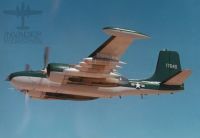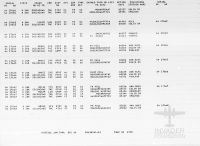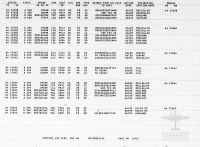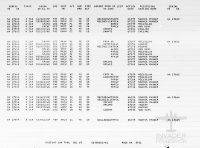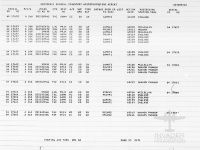64-17664
| B-26K-1 Invader | |||
|---|---|---|---|
| Builders: Douglas Aircraft Company On Mark Engineering | |||
| Operators: United States Air Force | |||
| Number Built: 40 | |||
| First Built: Jan 1963 (YB-26K) First test flight | |||
| GENERAL CHARACTERISTICS | |||
| Type: Light Attack Bomber | |||
| Weight: 25,130 lbs empty 37,000 lbs loaded | |||
| Length: 51' 7 3/16" (inc. guns) | |||
| Height: 19' 0" | |||
| Wingspan: 71'6" (including wingtip tanks) | |||
| Wing Area: 540 Sq. Feet (50.17 m²) | |||
| Speed: 169 mph (cruising) | |||
| Max Speed: 323 mph | |||
| Ceiling: 28,600' | |||
| Powerplant: Pratt & Whitney R-2800-103W | |||
| Horsepower: 2,500 | |||
| Fuel Capacity: 1,600 US Gallons | |||
| Range: 700 miles w/3518 lbs payload 1,480 miles empty | |||
| Crew: 2 | |||
| Passengers: 1 | |||
| ARMAMENT | |||
| Nose Guns: 8x .50 caliber guns | |||
| Dorsal Turret: None | |||
| Ventral Turret: None | |||
| Payload: 8,000 lbs on wings 4,000 lbs internal | |||
| Donate | |||
| Even a small donation of a couple of dollars goes a long way in helping | |||
See also: List of Invaders by Serial Number, Serial Numbers starting with 64
Converted from 43-22665.
Operational History
30 Dec 1964 - Accepted into USAF Inventory for OnMark Engineering Company in Van Nuys, CA [1]
31 Dec 1964 - Assigned to 1st Air Commando Wing at Hurlburt Field[1]
22 Dec 1965 - 1st Air Commando Wing moved from Hurlburt Field to England AFB.[1]
1 Mar 1966 - Sent to Sacramento Air Material Area (SMAAR) at McLellan AFB. [2]
5 May 1966 - Designation changed from B-26K to A-26A while assigned to SMAAR. [2]
28 May 1966 - Assigned to 1st Air Commando Wing at England AFB. [2]
31 Oct 1966 - Assigned to 603rd Air Commando Squadron at England AFB. [2]
16 Nov 1966 - Assigned to 1st Air Commando Wing at England AFB. [2]
1 Dec 1966 - Sent to Southeast Asia. [2]
21 Dec 1966 - Arrived at Nakhon Phanom Air Base. Assigned to 634th Combat Support Group. [3]
31 May 1967 - Assigned to 56th Air Commando Wing at Nakhon Phanom Air Base. [3]
9 Nov 1967 - Sent to Kadena AFB, Japan for Maintenance. [3]
15 Nov 1967 -Assigned to 18th Wing at Kadena AFB. [3]
27 Nov 1967 - Sent back to OnMark Engineering Company at Van Nuys, CA. [3]
16 Jan 1968 - Assigned to Sacramento Air Material Area (SMAAR)[4]
27 Apr 1968 - Assigned to 1st Air Commando Wing at England AFB. [4]
28 Apr 1968 - Arrived at 1st Air Commando Wing at England AFB. [4]
7 Jul 1968 - 1st Air Commando Wing renamed to 1st Special Operations Wing. [4]
4 Mar 1969 - Combat Support with 1st Special Operations Wing at England AFB.[5]
1 Jul 1969 - 1st Special Operations Wing moved from England AFB to Hurlburt Field. [5]
23 Oct 1969 - Arrived at Davis-Monthan AFB from 606th Special Operations Squadron, 1st Special Operations Wing, Eglin AFB, FL.[5][6] It was allocated PCN AD007.[7]
27 Oct 1969 - Put into Security Hold storage at Davis-Monthan. [5]
15 Dec 1972 - Marked as Excess and approved for reclamation [6]
2 Apr 1976 - Sold to Allied Aircraft, Inc of Tucson, AZ.[6]
Accidents
Unknown
Crew
Unknown
Disposition
Unknown
Images
Note that the original caption that came with this photo said that the plane was dumping fuel prior to an attack run. While that was a standard procedure, the crew of Special Kay (64-17679) has pointed out that this doesn't make sense. The wing pylons are empty, so there are no bombs and the bomb bay doors are closed. Additionally, the USAF "Stars and bars" insignia is displayed on the fuselage, which was not something that remained visible during combat in Vietnam. Once arriving in-country the stars and bars were removed from the special operations planes. They also note that the left engine is feathered and not running. Based on all of these factors I agree with their assessment that this plane is definitely not setting up for an attack run. Richard Fulwiler points out that dumping the wing tip tanks is standard procedure for landing (according to T.O. 1A-26A-1, Section 2-15, Descent item #12). This seems like it is a landing exercise at England AFB.
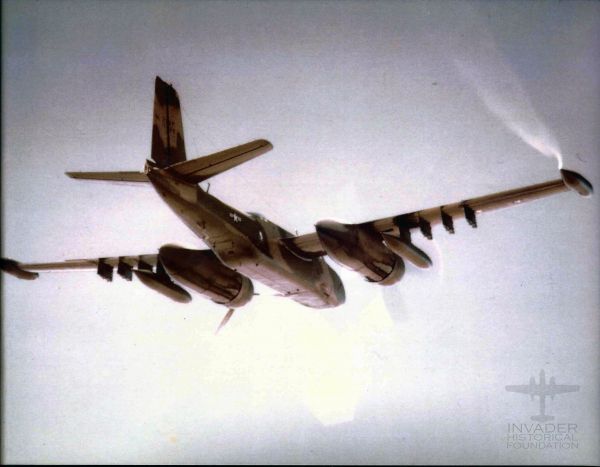
664 over the Pacific in Dec 1966 en route to Thailand. Note that the plane still has the grey underbelly used on training planes in the US and the paint scheme still has the small serial numbers.

64-17664 is visible in the back right corner of the photo wearing a glass nose. The conversion to a recon plane happened after arriving in Thailand.

This photo shows 664 on the left at NKP.

Sources
Databases searched:
- AAIR -
- MACR -
- KORWALD -
- Baugher
- ↑ 1.0 1.1 1.2 "Aerospace Vehicle Report, 1965" Reel AVH-4, Pg 1958 USAFHRA
- ↑ 2.0 2.1 2.2 2.3 2.4 2.5 "Aerospace Vehicle Report, 1966" Reel AVH-6, Pg 1946 USAFHRA
- ↑ 3.0 3.1 3.2 3.3 3.4 "Aerospace Vehicle Report, 1967" Reel AVH-8, Pg 2751 USAFHRA
- ↑ 4.0 4.1 4.2 4.3 "Aerospace Vehicle Report, 1968" Reel AVH-10, Pg 2371 USAFHRA
- ↑ 5.0 5.1 5.2 5.3 "Aerospace Vehicle Report, 1969" Reel AVH-13, Pg 2204 USAFHRA
- ↑ 6.0 6.1 6.2 www.amarcexperience.com
- ↑ Correspondence with Vesto Haas - 25 Aug 2022.
